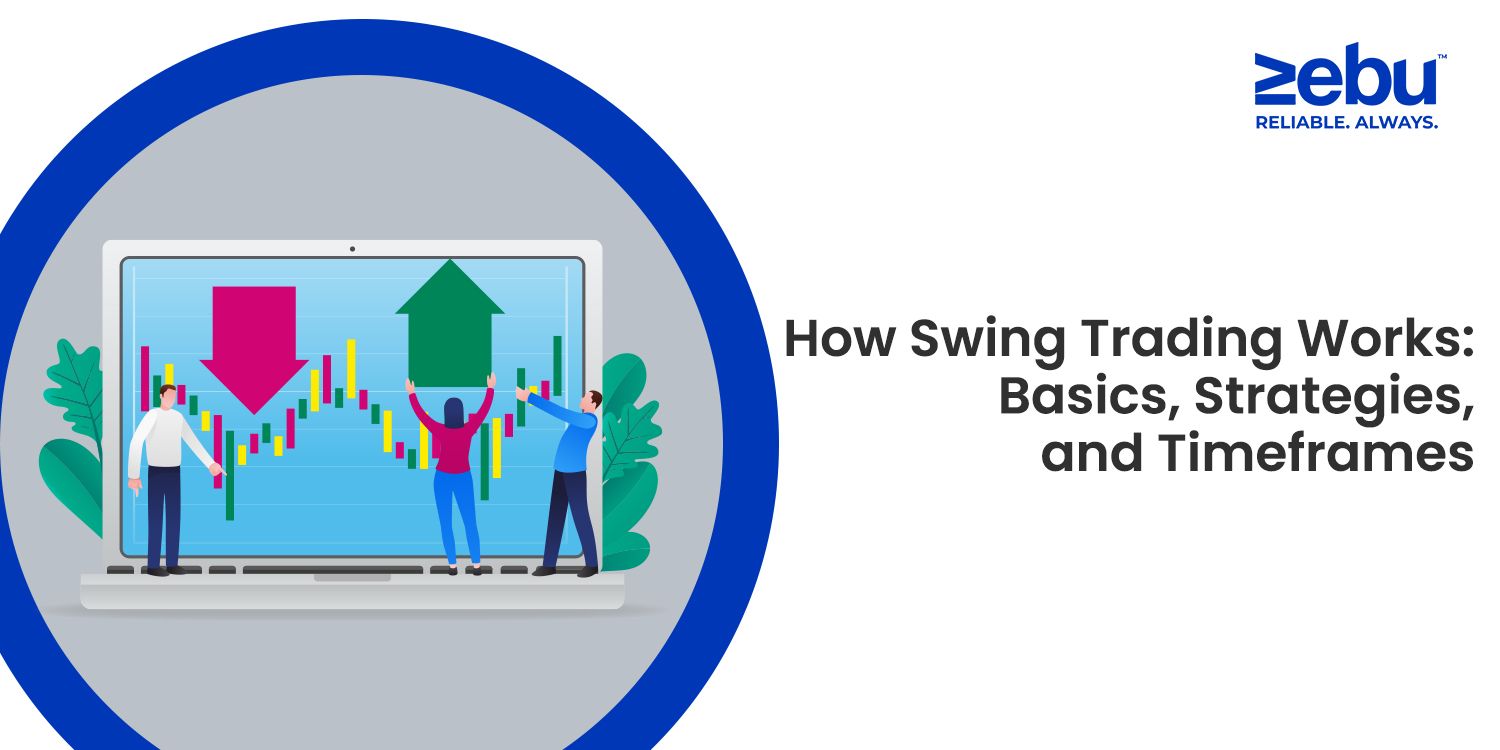
You’ve probably heard the term “swing trading” tossed around — maybe in trading groups, on financial news, or while scrolling through your trading app. It sounds active, maybe even aggressive, but in practice, swing trading is more measured than it seems.
At its core, swing trading is about taking trades that last longer than a day but shorter than a long-term investment. You’re holding a position through a “swing” in price — not chasing quick scalps, but not sitting in for months either.
For many, it’s a middle ground. It allows time for planning, analysis, and reflection. But it also moves fast enough to keep you engaged and aware.
What Is Swing Trading, Really?
The word “swing” is the key. It refers to price movement — up or down — that plays out over a few days or sometimes a couple of weeks. Traders who follow this method aren’t trying to catch the full trend. They just want a section of it. A clean move from a support level to resistance. A bounce. A dip.
A typical swing trade might last anywhere from two days to two weeks. But that’s not a rule. It’s just the range most people operate in. Some trades wrap up faster. Some take longer. The point is, you’re not trading every tick, and you’re not holding through multiple earnings cycles either.
What Makes Swing Trading Different?
The time horizon changes a lot of things.
First, it changes how you analyze a stock. If you’re day trading, you might stare at 1-minute or 5-minute charts. If you’re investing, you’re reading quarterly reports. For swing trading, most traders focus on daily charts, sometimes zooming into hourly or 4-hour charts to fine-tune entries.
Second, it changes your pace. Swing trading allows more time to think. You’re not glued to your screen. But you’re also not walking away for weeks. There’s balance. You watch price levels, news, and momentum — but with a little breathing room.
And finally, it affects how you manage risk. Your stop-losses and targets are wider than in intraday setups. That means you need to size your trades properly. You’re not aiming for 1% moves — you’re usually looking for 5–10%, depending on volatility.
Common Strategies Swing Traders Use
Swing trading isn’t random. Most traders stick to a few repeatable setups they trust over time. Here are some of them:
- Breakouts
Breakouts happen when a stock moves above a key resistance level that it struggled to cross earlier. This could be a price the stock hit several times before pulling back. When it finally breaks above with strong volume, it often signals momentum. Swing traders may enter right after the breakout and ride that momentum for a few days. - Pullbacks
When a stock makes a strong move — either up or down — it rarely goes in a straight line. There’s usually a pause, or a step back. That step back is what traders call a pullback.
It’s not a reversal. It’s more like the market catching its breath. Maybe the stock rallied hard, then slips a bit over a few sessions. If the trend is still intact, that drop can be an opportunity — a spot to enter the trade at a better price.
Swing traders often watch for these dips near areas like moving averages or previous support levels. If the price pulls back, slows down, and starts to show signs of turning back in the original direction, that’s where many step in. The goal isn’t to predict the bounce perfectly — just to catch a cleaner entry with less risk.
- Reversals
Reversals are a different story. Here, you’re not looking for the trend to continue — you’re watching for signs that it might be over.
Maybe the stock has been climbing steadily for weeks, but it starts to slow down near a resistance level. Or there’s a sharp move up followed by heavy selling on volume. Reversal trades often show up at the edge of big moves — the turning point where buyers become sellers or vice versa.
Since this means trading against the most recent direction, it usually takes more confirmation — you want to see the shift actually happening, not just guess that it might.
- Range Trading
Sometimes, the market doesn’t trend at all. Some stocks just move back and forth in a zone — up a few points, down a few points, again and again.
If you can spot a clear range, that can be just as tradable. You might look to buy near the lower boundary and sell near the upper end. This kind of trading works best when the stock isn’t reacting to news or breaking out — just moving steadily between familiar levels.
It takes patience to trade a range. And discipline. You have to accept that you’re not looking for a big breakout — just steady, controlled moves within the lines.
How Do You Pick Stocks for Swing Trading?
Not every stock makes sense for swing trades. You’re looking for ones that have direction — but also structure. Something you can read.
That might mean a recent breakout, a clean pullback to support, or even a reversal off a known level. You want price action that isn’t messy. You want volume. You want behavior that gives you room to plan.
The goal isn’t to find the busiest stock — it’s to find the one that moves in a way you understand.
The Role of Timeframes
Timeframes are flexible in swing trading, but the most common chart used is the daily chart. It gives you enough context without overwhelming you with noise. If the daily setup looks solid, traders might zoom into 4-hour or 1-hour charts to find precise entries.
However, timeframes aren’t rules. They’re tools. Some traders swing trade based on weekly setups. Others check 15-minute charts for entries. It depends on your approach and how often you monitor your trades.
What matters is consistency. You pick a system, and you stick to it long enough to see results.
Risk Management: A Quiet but Crucial Piece
No swing trading strategy works without proper risk control.
The most common tool is a stop-loss — a price level where you exit if the trade goes against you. It protects you from bigger losses and keeps emotions in check. Without one, a small red day can turn into a frustrating hold.
Traders also use target levels to take profits. Some scale out — taking partial profits along the way — while others exit all at once when the target is hit.
Trailing stop-losses are also used sometimes. These move up as the price rises, helping you lock in gains while giving the trade room to run.
Risk management isn’t exciting. But it’s the difference between surviving a bad trade and letting one mistake ruin your month.
Swing Trading on a Platform Like Zebu’s MYNT
The experience of swing trading also depends on the tools you use.
A platform like MYNT by Zebu gives access to real-time charts, technical indicators, and clear order types — so you can plan your entries and exits smoothly. Whether you’re using a limit order to control your entry price or a stop-loss to manage risk, MYNT helps with execution
You also get transparency — live price feeds, order book depth, and account views that let you monitor your trades without second-guessing.
For swing traders, this kind of clarity is key. You’re not staring at screens all day. You’re checking levels, watching setups, and stepping in with a plan.
Is Swing Trading for You?
That’s a personal question. It depends on your time, personality, and goals.
If you enjoy analysis, want some breathing room, and prefer holding trades for a few days rather than hours or months — swing trading offers that balance. You’re still active. You still make decisions every week. But you’re not reacting to every price tick.
On the flip side, swing trading requires patience. It means holding through small fluctuations. It means watching a trade sit flat for days before moving. And sometimes, it means missing the move entirely.
But for many, that in-between zone — not too fast, not too slow — is where trading starts to feel sustainable.
Final Thoughts
Swing trading isn’t about catching the exact top or bottom. It’s about understanding structure, planning well, and executing with discipline.
You’re not chasing. You’re not sitting idle. You’re stepping in when the setup makes sense, and you’re stepping out when the move is done.
That kind of rhythm takes time to build. But once it clicks, you stop guessing — and start trading with more clarity.
Disclaimer:
This article is for educational purposes only and does not offer financial advice. Trading involves risk. Always consult a qualified financial advisor before making investment decisions. Zebu Share and Wealth Management Pvt. Ltd. makes no guarantees regarding the outcomes of any strategy discussed.
- Which timeframe is best for swing trade?
Swing trading works best on daily or weekly charts, giving you time to catch trends without the stress of minute-by-minute monitoring.
- What are the most common swing trading strategies?
Popular strategies include trend following, breakout trading, and pullback trading, often applied to swing trading stocks with good liquidity.
- Is swing trading riskier than intraday trading?
Not necessarily. Swing trading strategies spread trades over days, reducing the pressure of intraday moves, though market swings still carry risk.
- Is swing trading a good option for beginners?
Yes, swing trading for beginners can be easier to manage than intraday trading because it allows more time for analysis and decision-making.
- What is the 2% rule in swing trading?
The 2% rule suggests you shouldn’t risk more than 2% of your capital on a single trade, helping manage losses and protect your portfolio.








